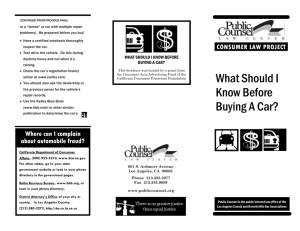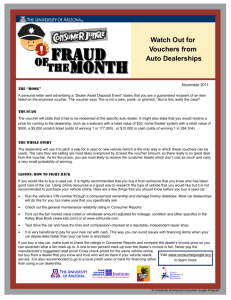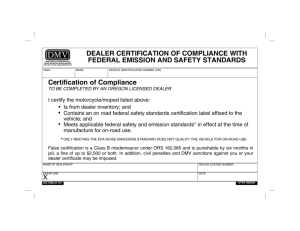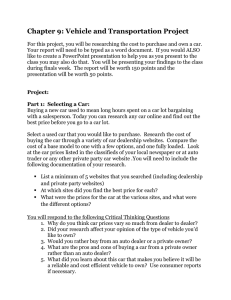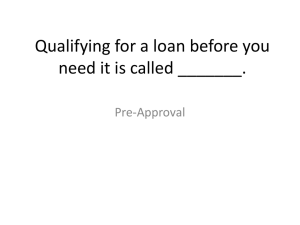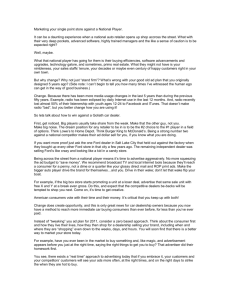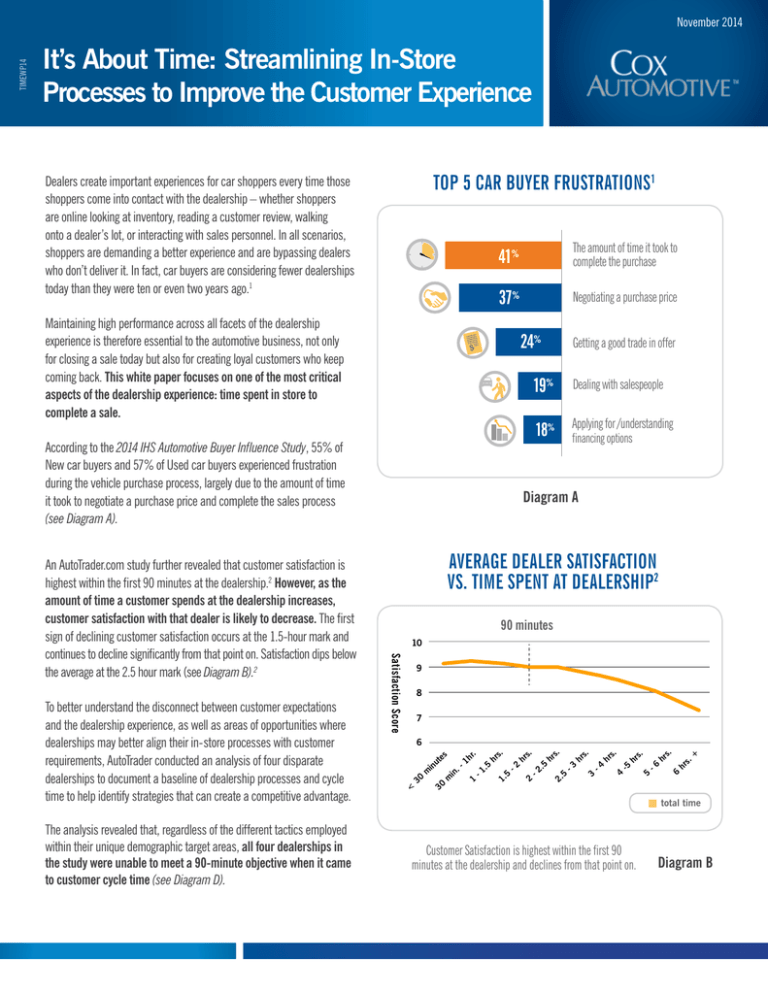
TIMEWP14
November 2014
It’s About Time: Streamlining In-Store
Processes to Improve the Customer Experience
TOP 5 CAR BUYER FRUSTRATIONS1
Dealers create important experiences for car shoppers every time those
shoppers come into contact with the dealership – whether shoppers
are online looking at inventory, reading a customer review, walking
onto a dealer’s lot, or interacting with sales personnel. In all scenarios,
shoppers are demanding a better experience and are bypassing dealers
who don’t deliver it. In fact, car buyers are considering fewer dealerships
today than they were ten or even two years ago.1
41%
The amount of time it took to
complete the purchase
37%
Negotiating a purchase price
Maintaining high performance across all facets of the dealership
experience is therefore essential to the automotive business, not only
for closing a sale today but also for creating loyal customers who keep
coming back. This white paper focuses on one of the most critical
aspects of the dealership experience: time spent in store to
complete a sale.
24%
According to the 2014 IHS Automotive Buyer Influence Study, 55% of
New car buyers and 57% of Used car buyers experienced frustration
during the vehicle purchase process, largely due to the amount of time
it took to negotiate a purchase price and complete the sales process
(see Diagram A).
To better understand the disconnect between customer expectations
and the dealership experience, as well as areas of opportunities where
dealerships may better align their in-store processes with customer
requirements, AutoTrader conducted an analysis of four disparate
dealerships to document a baseline of dealership processes and cycle
time to help identify strategies that can create a competitive advantage.
The analysis revealed that, regardless of the different tactics employed
within their unique demographic target areas, all four dealerships in
the study were unable to meet a 90-minute objective when it came
to customer cycle time (see Diagram D).
19%
Dealing with salespeople
18%
financing options
Applying for /understanding
Diagram A
AVERAGE DEALER SATISFACTION
VS. TIME SPENT AT DEALERSHIP2
90 minutes
10
Satisfaction Score
An AutoTrader.com study further revealed that customer satisfaction is
highest within the first 90 minutes at the dealership.2 However, as the
amount of time a customer spends at the dealership increases,
customer satisfaction with that dealer is likely to decrease. The first
sign of declining customer satisfaction occurs at the 1.5-hour mark and
continues to decline significantly from that point on. Satisfaction dips below
the average at the 2.5 hour mark (see Diagram B).2
Getting a good trade in offer
9
8
7
6
<
30
m
es
ut
in
30
m
i
n.
r.
1h
1
.5
-1
s.
hr
5
1.
-2
s.
hr
2
-
5
2.
s.
hr
2
.5
-3
s.
hr
3
-4
s.
hr
4
-5
s.
hr
5
-6
s.
hr
6
s.
hr
+
total time
Customer Satisfaction is highest within the first 90
minutes at the dealership and declines from that point on.
Diagram B
FOUR DEALERSHIPS, FOUR PHILOSOPHIES
ES
LE SAL
C
I
H
E
A. V
4. Vehicle
Financing
3. Vehicle
Appraisal
DEALER 3 is a forward-thinking dealership in the Northwest
near an urban area with a population of over 600,000. They focus on
the customer experience as well as customer in-store cycle time. They
maintain transparency in some, but not all, of their processes.
2. Customer
Information
Gathering
SALES
CLE
I
H
E
A. V
DEALER 2 is a volume-based commission dealership in the northern
Midwest near a population of over three million. This forward-thinking
dealership strives to reduce customer cycle time and focuses on the
customer experience.
The analysis documented actual cycle time across key dealer processes
from post-vehicle selection to pre-delivery of vehicle (see Diagram C).
Furthermore, the relative position of each dealership was assessed and
represented on a scale from “Traditional” to “Leading” (see page 8),
as well as future strategies and tactics that could improve the
customer experience.
AL
6. Aftermarket
Products
IN-STORE PROCESS
1. Vehicle
Selection
DEALER 4 is a lean dealership augmented by a used-vehicle wholesale
business. Located in a Midwestern city with a population of over 800,000,
they serve as a test environment for innovations that focus on improving
the customer experience.
5. Deal
Structuring
B. APP
RAI
S
DEALER 1 is a traditional franchise dealership located near a southeastern
U.S. city with a population of over four million. They focus on inventory
turn and “us versus them” sales tactics.
C. F&I
For the purposes of the study, four geographically and
demographically diverse dealerships participated in the analysis:
7. Complete
Paperwork
8. Vehicle
Delivery
Diagram C
The time study documented the current state of dealer processes and focused on
three specific areas: A) Vehicle Sales, B) Appraisals, and C) F&I. The ideal total cycle
time for these areas is 90 minutes combined, while the actual average time ranged
from 115 to 184 minutes. Note that the time study began after buyers made their
vehicle purchase selection.
Minutes
TOTAL CUSTOMER CYCLE TIME
Max
301 min
226 min
Avg
184
115
Min
103 min
43 min
DEALER 1
DEALER 2
Aggregated
results
unavailable
due to
lack of data
DEALER 3
208 min
151
103 min
DEALER 4
Despite their geographic, demographic and strategical/tactical differences, none of the four dealerships consistently meets their desired customer cycle time of 90 minutes.
Diagram D
2.
4. Vehicle
Financing
Vehicle
Financing
TIME
STUDY:
VEHICLE SALES PROCESS
5. Deal
Structuring
3. Vehicle
Appraisal
The vehicle sales process portion of the time study was conducted
from the point at which the customer made the decision to purchase
a vehicle and extended through the customer’s entry into F&I activities
(see Diagram E).
2. Customer
Information
Gathering
Vehicle Appraisal
The average time to complete the vehicle sales process across
all four dealerships was nearly 53 minutes – more than half the
desired ideal total customer cycle time of 90 minutes (see Diagram F).
Diagram E
1. Vehicle
Selection
The factors affecting the length of the vehicle sales process can
be broken down into three primary categories: People, Process
and Technology.
Customer Information
Gathering
6. Aftermarket
Products
A. VEHICLE SALES
PROCESS
7. Complete
Paperwork
8. Vehicle
Delivery
The vehicle sales process included Customer Information
Gathering, Vehicle Financing, and Deal Structuring.
Minutes
VEHICLE SALES PROCESS CYCLE TIME
Max
94 min
101 min
149 min
Avg
59
42
62
48
53
Min
35 min
8 min
11 min
37 min
DEALER 1
DEALER 2
DEALER 3
DEALER 4
Sales time
average across
dealers 1-4
66 min
Diagram F
People
•The vehicle sales process varied in length depending on
customer behavior and preparedness.
•Multiple personnel handoffs and a lack of adequate communication
between sales representatives and sales managers throughout
the vehicle sales process extended customer wait times.
•Gross vs. volume-based dealership models affected customer
time at the dealership with volume-based dealers having faster
in-store times.
Process
•Vehicle pricing negotiations caused re-working and process
step repetition that extended customer time at the dealership.
Negotiation took an average of 21 minutes and a maximum
of 41 minutes, making it potentially the most time-consuming
variable in the vehicle sales process.
•Providing the ability for customers to perform administrative
aspects of sales process upstream (e.g., online) may reduce the
amount of time customers spend in the dealership.
Technology
•Using a combination of paper forms and software to
perform sales functions created inefficiencies that extended
cycle times.
•A lack of streamlined software integration between credit
application systems, dealer management systems, desking
systems and F&I systems caused time-consuming repetition
of tasks.
•The inability to uniformly capture and push customer and
vehicle information into downstream systems caused
duplicative information capture that extended cycle times.
3.
TIME STUDY: VEHICLE APPRAISAL PROCESS
4. Vehicle
Financing
The vehicle appraisal process time study was conducted from the
notification of the customer’s intention to sell their vehicle through the
delivery of payment to the customer (see Diagram G).
The average time to complete the appraisals process was 43
minutes, nearly half of the total desired customer cycle time of 90
minutes (see Diagram H).
5. Deal
Structuring
3. Vehicle
Appraisal
2. Customer
Information
Gathering
Like the vehicle sales process, the factors affecting the length of the
vehicle appraisal process can be broken down into three primary
categories: People, Process and Technology.
6. Aftermarket
Products
B. VEHICLE
APPRAISAL
PROCESS
7. Complete
Paperwork
1. Vehicle
Selection
8. Vehicle
Delivery
People
•Customer wait time was increased by the involvement of multiple
appraisers using multiple paper forms and software systems.
Diagram G
The vehicle appraisal process included appraisal only.
•Cycle time was increased when appraisal tasks were handed off
from sales representatives to appraisers.
Technology
Process
•Trade-in pricing negotiations caused re-working and process
step repetition that extended customer time at the dealership.
Negotiation took an average of 16 minutes and a maximum of
39 minutes, making it a significant time-consuming variable in
the appraisal process.
•Gathering customer and vehicle information took the longest
average amount of time (18 minutes) in the appraisals process.
•The use of multiple software systems in the valuation process
increased customer wait time.
•Customer cycle time was extended when the dealership had
no electronic notification that an initial appraisal had been
completed and a secondary, more detailed appraisal was the
next step required.
•Providing the ability for customers to perform administrative aspects
of the appraisals process upstream (e.g., online) may reduce the
amount of time customers spend in the dealership.
Minutes
VEHICLE APPRAISAL PROCESS CYCLE TIME
Max
74 min
27 min
109 min
77 min
Avg
41
19
53
59
Min
21 min
12 min
20 min
42 min
DEALER 1
DEALER 2
Diagram H
4.
DEALER 3
DEALER 4
43
Appraisal
average time
across dealers
1-4
VE
HI
4. Vehicle
TIME STUDY:
F&I PROCESS
Financing
5. Deal
C
LE
S
4. Vehicle
Financing
AL
ES
Structuring
APPR
The
F&I process time study was conducted from the point at which
3. Vehicle
theAppraisal
F&I manager began processing the deal and extended through the
6. Aftermarket
completion of the vehicle purchase paperwork
(see Diagram I).
5. Deal
Structuring
3. Vehicle
Appraisal
Products
AIS AL S
6. Aftermarket
Products
F&I
average time to complete the F&I process was nearly 61
2. The
Customer
Information
minutes – two-thirds of the desired length of the ideal total customer
Gathering
cycle time of 90 minutes (see Diagram J).
C. F&I PROCESS
2. Customer
Information
Gathering
7. Complete
Paperwork
1. Vehicle
Like the sales
and appraisal processes, the factors affecting the
Selection
8. Vehicle
length of the F&I process can
be broken down into the three primary
Delivery
categories: People, Process
and Technology.
7. Complete
Paperwork
1. Vehicle
Selection
8. Vehicle
Delivery
People
•The F&I process can vary in length depending on customer
behavior, the customer’s knowledge of the process, and the
dealership’s strategy (e.g., wearing down customers versus
working collaboratively).
Diagram I
The F&I process included the aftermarket product
pitch and completing all necessary paperwork.
•Customer cycle time was increased when F&I tasks were handed
off from sales representatives to an F&I manager.
average of 21 minutes and a maximum of 44 minutes, making it
a significant time-consuming variable in the F&I process.
Process
•F&I cycle time was increased when the dealership was required
to act as the “middleman” during multiple communications
between the customer and the lending institution.
•Customers were often unaware of the F&I aftermarket pitch.
Educating the customer and allowing them to reach a decision
during the aftermarket pitch took an average of 28 minutes,
making it the longest step in the F&I process.
•Customer time at the dealership was increased due to lack of
electronic notification that the deal was ready to be processed by
F&I, or that the F&I process was complete.
Technology
•The F&I process is lengthened by requiring signatures on multiple
paper forms (e.g., federal, state and dealership contracts, titles,
power of attorney forms, etc.). Filling out these forms took an
•Lack of streamlined transfer of information between systems
caused duplicative data entry (e.g., aftermarket menus were
separate from the dealer management system).
F&I PROCESS CYCLE TIME
Minutes
Max
133 min
65 min
98 min
Avg
84
54
Min
47 min
24 min
DEALER 1
DEALER 2
N/A due to
turnover
of F&I staff
44
24 min
DEALER 3
61
Average F&I
Time Across
Dealers 1-4
DEALER 4
Diagram J
5.
Top Reasons for Inefficiencies
Potential for improvement
1) Negotiations
Increased Transparency and Facilitate Trust;
Use a Limited Negotiation or “One-Price” Strategy
2) Administrative Tasks and Wait Time
Lift and Shift Administrative Tasks Upstream;
Provide Customer “Self-Serve” Options
3) Fractured Software Environment
Focus on Integrated Software Solutions
Diagram K
CONCLUSIONS
Time studies of the vehicle sales, appraisals and F&I processes
not only revealed top reasons for inefficiencies and the potential
for improvement (see Diagram K), they also illuminated the current
dealership landscape and identified trends that will define the future
state of dealership operations.
The Present
In the current dealership landscape, a lack of transparency during
customer interactions with sales and F&I personnel often results
in distrust and causes many customers to feel intimidated. The
non-linear and complex sales process is rife with potential dealbreaking decision points. Additionally, dealerships often rely on a
wide variety of disparate systems to run their businesses (e.g., CRM,
inventory management, credit, appraisals, finance, titling, etc.).
Making all of these systems function efficiently together is often
difficult and requires duplication of tasks that increases process
time and can negatively impact the customer experience.
the offline stages of the car-buying process, satisfaction numbers
start to decline significantly (see Diagram L). An integrated system
that more effectively bridges the online and offline aspects of the
car-shopping experience could provide consumers with a positive
dealership experience that can contribute to improved Customer
Satisfaction Index (CSI) scores.2
Future dealerships can further positively impact the customer
experience by striving to provide a single point of contact for the
customer throughout the sales process, by implementing an efficient
standardized process where most activities occur offsite, and by
ensuring that major customer decision points occur as close to the
initiation of the sales process as possible (see Diagram M).
BUYERS’ LEVEL OF SATISFACTION3
76%
63%
In-Store / Offline
62%
57%
56%
52%
47%
The Future
While the activities may be the same, the process will look different.
Ideally, dealerships of the future will use singular end-to-end
systems that streamline the vehicle sales process by more
thoroughly integrating online and in-store activities. This integration
should be designed to give autonomy and transparency to the
customer while minimizing the often stressful time customers
spend in-store.
Research shows that consumers are most satisfied with shopping
activities that largely take place online. Once customers reach
6.
43%
37%
Researching
vehicle
features &
options
Searching
dealership
inventory
Finding
info on
incentives,
specials &
rebates
Finding the
best
deal/price
Finding
the right
dealership
Negotiating
a purchase
price
Filling out
paperwork
Car buyers report lower satisfaction with car-shopping activities that
traditionally have occurred in the in- store environment.
Applying for
financing
Receiving
a trade-in
offer
Diagram L
Traditional
Multiple dealership employees
interact with the customer
Future State
vs
One salesperson leading the customer
Process variation
Process standardization within and
across multiple mediums (e.g., customer
self-serve in-store or online)
Majority of activities occur onsite
Majority of activities occur offsite
Potential process-ending decision
points (e.g., credit checks) occur
near the end of the process
Potential process-ending decision points
occur near the start of the process
Systems support the process
Multiple systems do not interface
with each other
Maximize the profitability
of each deal
A system dictates the process
An integrated end-to-end system
ensures maxium efficiency
Maximize customer satisfaction/reduce
cycle time
Diagram M
7.
DEALER 3
DEALER 2
DEALER 4
DEALER 1
LEADING
TRADITIONAL
DEALERSHIPS RANKING
Diagram N
FROM TRADITIONAL TO LEADING: HOW
THE DEALERSHIPS RANKED
In addition to documenting customer cycle time across key dealer
processes, the in-depth examination of dealership operations
revealed the relative position of the four dealerships as represented
on a scale from “Traditional” to “Leading” (see Diagram N).
Traditional dealerships are defined as those that rely less on
technology, strive to conduct their sales process primarily in-store,
and focus on gross-maximizing sales tactics. Conversely, leading
dealerships are defined as those that embrace technology, strive to
take advantage of combining online and offline processes, focus on
reducing cycle time, and foster greater transaction transparency to
ensure long-term viability in the marketplace.
DEALER 1 was ranked as the most traditional dealership in the
study. Their reliance upon separate CRM, appraisal, desking (credit and
DMS), titling and aftermarket menu systems and multiple hard-copy
worksheets caused significant increases in cycle time. While Dealer
1 was willing to conduct offsite transactions through their Internet
Department, their available self-serve options were not user-friendly
and therefore required the customers to complete the sales process in
the store. Negotiations consumed an average of three hours, largely as
a result of a culture that is less concerned with cycle time and more
concerned with maximizing profit on each deal. Customers typically
had to interact with a sales representative, a sales manager and F&I
personnel. The physical layout of the store is based on traditional
boundaries that foster a lack of transparency (e.g., management is
concealed on a raised platform, F&I is located in back offices).
DEALER 3 ranked squarely in the middle between “Traditional”
and “Leading.” Like Dealer 1, their reliance on separate CRM,
appraisal, desking and aftermarket menu systems negatively impacted
cycle time. Multiple hard copy forms, including a customer sheet,
8.
deal jacket and credit application, further lengthened the process.
Dealer 3 discourages online/offsite completion of buying process
steps and offers customer self-serve options only under extenuating
circumstances. However, unlike Dealer 1’s negotiation-centric
philosophy, Dealer 3 strives to maintain a standardized “one-price”
process and promotes a culture focused on reducing cycle time.
Placing the sales representatives and managers in equally accessible
cubes on the showroom floor creates a physical layout that is more
conducive to conveying transparency than Dealer 1’s layout. However,
F&I personnel remain in back offices.
DEALER 4 was ranked as more “Leading” than “Traditional”
in the study. While their reliance on disparate systems added to
customer wait times, Dealer 4’s automation of some tasks has
allowed them to eliminate most hard copy forms. Customer selfserve options are currently unavailable, but their process was more
efficiently standardized than the two more traditional dealers on
our scale. Dealer 4 negotiates on the trade-in vehicle only. Sales
representatives, managers and F&I personnel share the sales floor
and customers do not have to relocate to complete different steps
in the sales process. The dealership fosters a culture dedicated to
improving the customer experience by building trust and transparency.
A trade-appraisal program encourages sales personnel to focus on
customer satisfaction rather than volume or gross profit.
DEALER 2 was ranked as the study’s most “Leading” dealership.
Like the other dealerships in the study, Dealer 2’s reliance on disparate
systems for CRM, appraisal, desking, etc., lengthened customer
cycle time. The dealership still uses some hard copy forms such as a
customer data sheet, deal jacket, and credit application. Customers
are encouraged to complete the sales process in-store, although
self-serve options are available. However, their no-negotiation
pricing strategy increases customer satisfaction and the dealership
fosters a culture devoted to reducing cycle time and promoting trust
and transparency. Most personnel reside openly on the sales floor,
including the GM. Their highly standardized process takes an average
of less than two hours to complete.
Leading Dealership Best Practices
Driving Innovation: The Role of Cox Automotive
Moving from traditional dealer operations to leading dealer operations
will require a seismic cultural shift affecting a dealership’s people,
processes and technology. In order to transform, dealerships will
require investments in:
•Reviewing and improving internal dealership processes,
operations, and technology
Cox Automotive is committed to furthering the evolution of dealership
operations through analyses/diagnostics, prescriptive recommendations,
sharing best practices and benchmarks, and promoting understanding
of the relative benefits of specific improvement efforts. Most
importantly, Cox Automotive will continue to develop products and
platforms that drive dealership systems integration, improve sales
process efficiency, enhance dealer profitability and increase the
customer satisfaction on which the industry ultimately depends.
•Informing, training, incentivizing and marketing new
operational capabilities to the customer
About Cox Automotive
•Hiring, training and coaching personnel
Industry-leading future dealerships will:
•Complete customer transactions within 90 minutes
as opposed to requiring customers to spend longer hours
in the dealership.
•Use a single end-to-end system instead of multiple systems
that do not interface across sub-processes.
•Automate and streamline the process instead of using
manual forms to transfer information.
•Maximize customer self-service availability and reduce
cycle time by promoting the use of different mediums to
complete process steps offsite (instead of mandating that the
process be completed end-to-end onsite).
•Offer fixed prices with little or no negotiations as opposed to
including haggling as part of the process.
•Emphasize a culture focused on customer satisfaction by
reducing cycle time as opposed to being relatively unconcerned
about how long customers are onsite.
•Have a single sales representative guide the customer from
start to finish as opposed to having the customer meet with
several different people throughout the process.
Cox Automotive is a leader in vehicle remarketing services and
digital marketing and software solutions for automotive dealers
and consumers. Cox Automotive, a subsidiary of Atlanta-based Cox
Enterprises, includes Manheim, AutoTrader.com, Kelley Blue Book and
a host of global businesses and brands serving customers such as
auto dealers, manufacturers and financial institutions. Headquartered
in Atlanta, Cox Automotive employs nearly 24,000 employees in over
150 locations worldwide. We partner with more than 40,000 dealers
and touch over 67 percent of all car buyers in the U.S. with the most
recognized brands in the industry. We unite over 20 brands in this
space, providing an end-to-end solution to transform the way people
buy and sell cars every day.
Industry-leading dealerships will
be able to complete the entire sales
process within 90 minutes.
•Have a store with a physical layout that conveys transparency
to the customer (e.g., personnel remain on the sales floor as
opposed to having a showroom filled with offices that can
be intimidating).
• Foster transparency and trust with the customer as opposed
to maintaining artificial barriers designed to keep dealership
information confidential.
9.
NOTES
10.
NOTES
11.
© 2014 Cox Automotive. All Rights Reserved. “AutoTrader.com” is a registered trademark of TPI Holdings Inc. used under exclusive license.
Sources: 1 2014 IHS Automotive Buyer Influence Study 2AutoTrader.com Dealer Customer Sourcing Studies, March 2014 32012 Morpace/AutoTrader.com Dealership Experience Study
14_Q2_026

